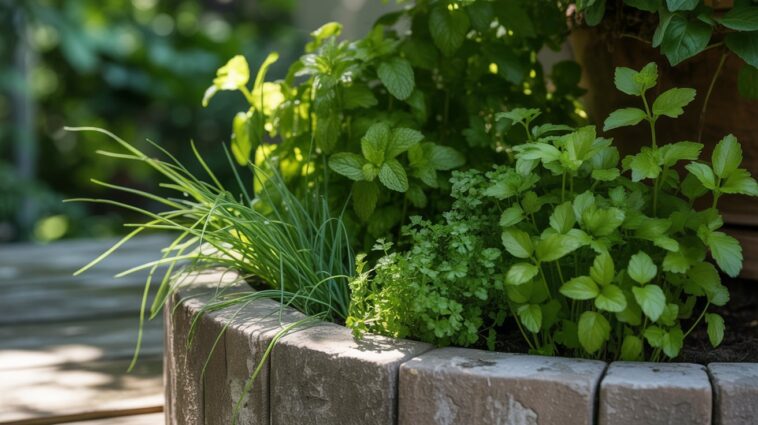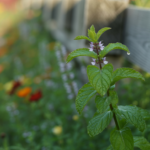When I first started gardening, I believed herbs were sun-loving plants that needed at least six hours of full sunlight a day. And while that’s true for Mediterranean classics like rosemary and thyme, I soon discovered that there’s a whole world of herbs that not only tolerate shade—but actually thrive in it.
This was a game-changer for me. My yard has plenty of pockets of shade: under trees, beside the house, and along the fence line. Once I realized those areas could support lush, productive herbs, my garden doubled in usefulness. If you’re working with a shady balcony, a north-facing garden, or just a yard with a few mature trees, don’t worry—there are still so many herbs you can grow successfully. These are 15 of my favorites, all of which I’ve grown myself in low-light conditions with great results.
Mint
Mint is hands-down one of the best herbs for shade. In fact, it prefers part shade in hot climates because full sun can make it wilt. I grow several types—spearmint, peppermint, and chocolate mint—all in containers because mint tends to spread aggressively. Give it moist soil and watch it take off.
Lemon Balm
Lemon balm is a gentle, lemon-scented herb that’s part of the mint family. It’s another one that appreciates some shade, especially in summer. Mine grows happily under a tall oak tree and attracts plenty of bees when it blooms.
Parsley
Parsley is surprisingly tolerant of shade. It grows slower than in sun, but the leaves are darker, more tender, and intensely flavorful. I always keep a pot of flat-leaf and curly parsley tucked in a cool corner near my kitchen door.
Chives
Chives are remarkably adaptable and do well in partial shade. I grow them around the base of my tomato containers to maximize space, and they don’t seem to mind the filtered light. Plus, those purple flowers are edible and beautiful.
Cilantro
Cilantro bolts quickly in hot sun, which is why I’ve found it does best in my garden when grown in spring or fall in partial shade. The leaves stay tender longer, and I get a longer harvest window before it starts to flower.
Lovage
If you’ve never tried lovage, it tastes like celery with a stronger herbal punch. This tall perennial can tolerate dappled shade and prefers it in warm regions. I grow mine on the north side of my garden and harvest leaves regularly for soups and stocks.
Sorrel
This tangy, lemon-flavored herb is a shade-lover by nature. I’ve got French sorrel growing happily near my compost bin in a mostly shaded bed. The leaves are fantastic in salads, quiches, or blended into sauces.
Sweet Woodruff
I originally planted sweet woodruff as a groundcover beneath a dogwood tree, not knowing it was edible. But the fragrant leaves can be used to infuse syrups, wines, or teas. It thrives in full shade and forms a beautiful green carpet with tiny white flowers in spring.
Wild Bergamot (Bee Balm)
Bee balm will grow in partial shade, especially in woodland edges or semi-shaded garden beds. It’s a pollinator magnet and produces lovely lavender-red flowers. I dry the leaves and flowers to make a fragrant herbal tea with hints of oregano and mint.
Catnip
Catnip isn’t just for cats—though mine certainly appreciate it. The leaves can be used in teas for humans as a calming herb. It tolerates shade well and tends to grow bushier with less sun. I keep mine under a lilac bush where it stays protected and lush.
Garlic Mustard
This one’s actually a wild herb—and yes, it’s often considered invasive—but it grows extremely well in shade and has a garlicky flavor that I use in pestos and green sauces. Just harvest it before it flowers to keep it under control.
Vietnamese Coriander
Unlike true cilantro, this heat-loving herb does great in shade and stays productive all summer long. The leaves have a spicy, citrusy flavor that I love adding to fresh spring rolls or noodle dishes. It needs consistent moisture, so I grow it in a pot in a shady, damp corner.
Wasabi Arugula
Spicy and bold, wasabi arugula grows surprisingly well in partial shade. I grow it in the shadow of my tall sunflowers and harvest the leaves young for a peppery bite in sandwiches and salads. It tends to bolt more slowly in lower light, which is a big plus.
Anise Hyssop
This tall, licorice-scented herb can grow in dappled shade and still produce its purple spires of flowers, which are beloved by bees. I use the leaves for tea or dry them to blend with other herbs. It adds a unique depth to herbal blends.
Sweet Cicely
Sweet cicely is an old-fashioned herb with fern-like leaves and a faint anise flavor. It thrives in deep shade and grows wild in parts of Europe. I started mine from seed and now keep it near a shaded wall where it softens the space and provides fresh leaves for sweetening teas or desserts.
I used to think of shady areas as wasted space, but now I see them as hidden herb gardens waiting to happen. Many of these herbs actually grow better when shielded from intense afternoon sun. Their leaves stay more tender, their flavor more balanced, and they’re often less prone to bolting or drying out.
If you’ve been ignoring the shady corners of your yard, I encourage you to take a second look. Grab a few herb starts from the nursery or propagate your own, tuck them into those low-light spots, and watch your garden come to life in a whole new way. There’s something incredibly satisfying about harvesting a handful of fresh herbs from a place you once thought was too dim to grow anything.
And honestly, there’s nothing quite like snipping a few mint leaves from the cool shade on a hot summer afternoon. Try it—you’ll see what I mean.


